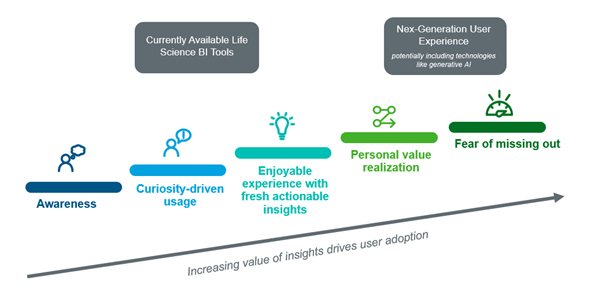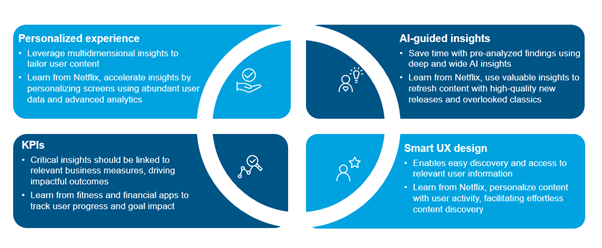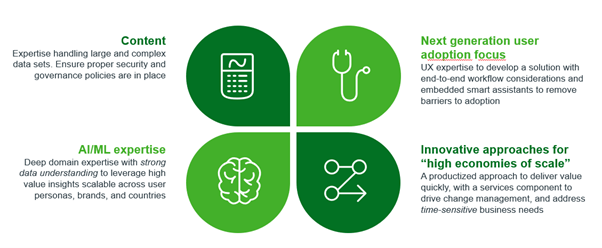Combine data science, technology, and analytics driven by artificial intelligence to support new efficiencies and business insights -- without additional capital investment.






















- Blogs
- How to optimize adoption and ROI of business intelligence technology
When watching TV, do you prefer a streaming service over browsing multiple channels?
Most people do because the precision of recommendations provided by a service like Netflix can save hours of sorting through options.
The same concept is applicable to life sciences business intelligence, where we’re beginning to see opportunities for greater personalization and a more simplified user experience.
Current state of life sciences business intelligence (BI) tools
While life sciences organizations have heavily invested in BI solutions, users do not yet have access to the level of personalization we see in B2C interfaces like Netflix. Instead, they see “static overloaded dashboards”, which share insights with a short “shelf life” that lack user-specificity. Users instead must actively interrupt their daily workflow to access graphs, insights, or recommendations in another application, which can reduce usage. Thus, intelligence transformation fails or delivers only a fraction of the value.
Given the growing complexity of the commercial landscape, life sciences companies need to prioritize providing a better user experience that quickly and tangibly drives business value. A 2023 McKinsey survey of data and analytics leaders in the life sciences estimated that digital and analytics drove a 5-15% bottom-line financial improvement in the past 5 years but that full application of digital solutions and innovation along the life sciences value chain could further increase the annual global impact by 20x1.
Driving adoption is the key to realize greater value from BI solutions. However, unless the challenges described earlier are addressed, and unless the BI solutions are designed to provide meaningful insights quickly, organizations will continue to struggle with adoption of business analytics2. The diagram below summarizes our view on the behavioral adoption pattern of users and is the business value of focusing on a next-generation user experience to drive adoption.
Adoption Pattern for Life Sciences Analytics Technologies

As the volume of available tools increases, expectation to deliver value quickly are also increasing. This is particularly critical in the rapidly changing life science commercial space, where meaningful insights need to be consumed and acted on quickly to stay competitive. For example, due to the easy user interface and valuable insights delivered to users, ChatGPT gained significant traction within days of launch, with one million users gained in just five days, and now, 40% of adults in the United States are aware of ChatGPT3.
Three key elements for driving high user satisfaction from the start
Efficiency is key; users must feel they can accomplish more or achieve their objectives faster, with minimal disruption to their current activities. There are three elements to this:
- Simplifying the discovery process for effective decision-making
- Designing a personalized, intuitive user experience that eliminates the need for training
- Delivering insights in a matter of seconds
The key components to addressing these elements, including best practices from other industries are summarized in the graphic below.
Getting Started

Partnering with the right life sciences vendor is the most cost-effective option
User adoption must be driven by tools built to navigate the complexity of the life sciences industry, including organizational guardrails. The adoption of industry-agnostic tools has led to challenges in scalability across multiple users, brands, and countries. Choosing a vendor with deep domain and technical expertise is critical to meet the needs of life sciences companies (of any size), provide a single “source of truth” to drive adoption and transparency, and ultimately, maximize ROI realization.
Criteria for choosing the right Life Sciences Partner

The key to motivating ongoing usage: flexibility within organizational guardrails
One additional element our customers often find lacking in enterprise tools but can greatly incent ongoing usage is offering flexible options to users that can boost their productivity and effectiveness. These options include the ability to subscribe to new insights, receive additional suggestions, and disseminate insights to their daily workflow tools such as email and mobile texts. This flexibility empowers users to apply their knowledge and expertise to particular customer segments or local needs while still operating within the guardrails of what is allowed in their organization.
The adaptive “Netflix-like” user experience is here, and it helps maximize value from your existing investments
Thankfully, adaptive user experiences are now available outside of mass consumer apps. At IQVIA, we have spent the last year leveraging our expertise to integrate adaptive experiences into our commercial intelligence technology platforms, which can work alongside existing BI tools.
We offer a personalized experience so that every user type, whether that be a field force sales representative, an MSL, a digital marketer, or a brand owner, gets elevated intelligence that is specific not only to their role but also to their individual preferences. Using our industry expertise, we have also incorporated governance for proper security, privacy, and access policies.
This is just the beginning of our journey. At the customer-level, IQVIA’s tools continuously adapt and grow alongside an organization’s digital maturity, surfacing newer and more advanced insights and recommendations as the underlying data and process enablers change. And at the broader market-level, our approach ensures our capabilities evolve alongside the data and digital transformation landscapes.
To dive deeper and hear from IQVIA experts on the importance of business intelligence tools, watch the on-demand webinar: "A Fresh Approach to Driving Adoption of Life Science Business Intelligence Tools – Bringing An “Outside-In” Perspective"
To explore additional content on this topic or to contact a member of the IQVIA team please visit our website.
Sources
1. Albrecht B, de Fremond S, Devenyns T, et al. Top ten observations from 2022 in life sciences digital and analytics [internet]. Mckinsey Report; 2023. Available from: https://www.mckinsey.com/industries/life-sciences/our-insights/top-ten-observations-from-2022-in-life-sciences-digital-and-analytics#/
2. Atkin M, Nass D. Improving decision-making through connected intelligence [internet]. Institute Report; 2022. Available from: iqvia-institute-improving-decision-making-through-connected-intelligence.pdf
3. Thormundsson B. ChatGPT- Statistics and Facts [internet]. Statista; 2023. Available from: https://www.statista.com/topics/10446/chatgpt/#editorsPicks
Related solutions
IQVIA Orchestrated Analytics connects actionable, intelligent insights across commercial teams to empower improved strategic decision making.





